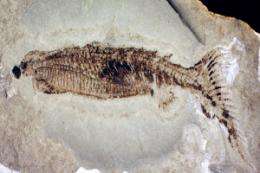Unusual anal fin offers new insight into evolution

(Phys.org) —An unusual fossil fish that has fins behind its anus could have implications for human evolution according to a scientist at The University of Manchester.
Dr Robert Sansom from the Faculty of Life Sciences identified the paired fins of Euphanerops, a fossil jawless fish that swam in the seas around 370 million years ago. The find makes the fish one of the first vertebrate to develop paired appendages such as fins, legs or arms.
However, their positioning is incredibly unusual, as Dr Sansom explains: "Euphanerops is unique because its anal fin is paired meaning there is one fin on each side of the fish. Up until now anal fins have only been seen on jawed fish where they are unpaired and this is true of both extinct and modern fish. The age of Euphanerops is important as it dates from the time of a deep evolutionary split between jawed and jawless fish, the two main divisions of vertebrates alive today. As such, it represents an important stage in the evolution of paired appendages."
He continues: "It's not clear why the fins are positioned so far back on the fish, or what advantage they might have provided. However, they do show that our early vertebrate ancestors tried out lots of different body plans before settling on two arms and two legs. If they hadn't then our bodies would have looked very different!"
Dr Sansom came across the paired fins as part of a study of Euphanerops fossils in Quebec, Canada. 3D surface scans of fossils and comparison of specimens preserved in different conditions revealed that there were two fan-shaped fins, a left and a right.
Dr Sansom's research on the paired fins followed on from a 2009 study of early vertebrate evolution and fossil preservation with colleagues from The University of Leicester. Their findings have been published in the Royal Society's journal Biology Letters.
Dr Sansom says it was an exciting find: "The unusual paired anal fin of Euphanerops lends support to the idea that there was some degree of developmental and evolutionary experimentation in some fish. After the Devonian period and the extinction of a lot of species, the jawed vertebrate body exhibits fewer deviations from the formula of paired pectoral, paired pelvic, unpaired dorsal and unpaired anal appendages. The discovery of new anatomical conditions will hopefully shed more light on the timing and sequence of the events underlying the origin and diversification of vertebrate appendages."
More information: The full title is: "Unusual anal fin in a Devonian jawless vertebrate reveals complex origins of paired appendages." The paper can be viewed on the Royal Society's website rsbl.royalsocietypublishing.or … content/9/3/20130002
Journal information: Biology Letters
Provided by University of Manchester



















